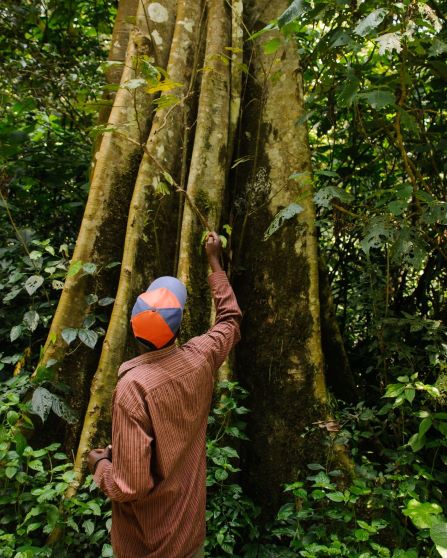This blog was originally published on Cities4Forest.
At COP27 in Sharm-El Sheik, Egypt, all eyes are on Africa. COP27 has been coined as “Africa’s COP”, not only due to the region’s role as host, but also because the stakes are particularly high for countries in the region. Communities in Africa are predicted to experience some of the most intense impacts from climate change. The increased frequency and severity of higher temperatures, sea level rise, and rainfall anomalies will severely impact lives and livelihoods, economic growth, and human and biodiversity health. The outcomes of the COP will be critical for determining a resilient future for Africa.

Creating this resilient future is easier said than done. Nature-based solutions (NBS) can play a vital role in building community resilience and mitigating the impacts of climate change. However, obstacles to realizing the potential of NBS are four-fold: (1) there is a lack of understanding in where NBS projects are currently active and at what scale, (2) there is little incorporation of NBS into policy frameworks, (3) access to funding and financing is limited and shrinking in the current fiscal space, and (4) there is a lack of technical capacity to design, implement, and maintain NBS projects.
Given what is at stake, COP27 is a critical moment to dive deeper into the current state of play and look to the future of NBS projects across the region. Governments, investors, development organizations, and other critical actors must invest in creating a baseline to understand the state of NBS in Africa. From there, they must also support strategies that address the barriers that prevent scaling up NBS projects in a context-specific, tailored way so that limited resources are used wisely and the region can equitably receive the benefits of NBS.
NBS in Africa: The Current State of Play
To start, what are NBS, and why should they be a priority?
NBS are actions to address societal challenges through the protection, sustainable management, and restoration of ecosystems. They offer tremendous untapped opportunities to build sustainability and resilience into economic recovery and infrastructure investments. This is critical, as adapting to the impacts of climate change in sub-Saharan Africa will cost between US$30-50 billion each year until 2030, representing 2-3% of the region’s GDP.
Tightened budgets as a result of economic disruptions from the COVID-19 pandemic and the Russian invasion of Ukraine further strain countries’ abilities to financially respond and recover to climate impacts. Each dollar spent on adaptation, therefore, must be carefully allocated to yield benefits for people, climate, and nature. A robust evidence base has demonstrated that NBS can do just that. For example, NBS can deliver resilience to climate change: wetlands and forests can absorb and filter flood waters, which helps to protect downstream communities, maintain water supply, and avoid damages to buildings and roads. NBS can also generate economic gains through immediate job creation, tourism, promoting social equity, and increased productivity for food, fish, and timber. In fact, studies show investments in natural capital can create almost twice as many jobs per million dollars spent compared to traditional infrastructure investments. Finally, NBS deliver a number of co-benefits, including enhanced human health, biodiversity protection, food security, and carbon sequestration.
To evaluate the current status and trends of NBS uptake in sub-Saharan Africa, WRI partnered with the World Bank through its Global Facility for Disaster Risk Reduction and the African Development Bank to examine their lending portfolios for projects that included NBS for climate and water resilience objectives. The inventory identified 85 projects: 46 from the World Bank amounting to approximately US$2.4 billion in components with NBS, and 39 from the African Development Bank amounting to approximately US$2 billion in components with NBS. This work also identified several countries where NBS are gaining traction, including Ethiopia (with 10 projects), Ghana (7), Malawi (7), Tanzania (6), Uganda (6), and the Democratic Republic of the Congo (5).
Despite this encouraging progress and a growing enthusiasm for NBS on the part of both multilateral development banks (MDBs) and the countries that they work in, NBS have yet to become routine and mainstream in Africa. Of the US$79.6 billion of climate finance issued globally by developed countries in 2019, less than 1.5% of climate finance flowed to NBS for adaptation, representing an urgent opportunity for expansion. However, several persistent barriers — including policy, financial, and technical challenges — stymie NBS project development in the region. These challenges affect MDBs and their government clients, as well as bilateral donors, private sector actors, infrastructure investors, and community organizations.
3 Strategies to Scale NBS in Africa
To explore strategies to overcome these barriers in the region, WRI through its Cities4Forests initiative and partners, the World Bank and its Global Facility for Disaster Reduction and Recovery (GFDRR), the African Development Bank (AfDB), Green Growth Knowledge Partnership (GGKP) with support from the United Nations Environment Programme (UNEP) and the Global Green Growth Institute (GGGI), Deutsche Gesellschaft für Internationale Zusammenarbeit (GIZ), Swedish International Development Cooperation Agency (SIDA), and the Caterpillar Foundation, hosted an NBS-focused workshop in Nairobi, Kenya in October 2022. The workshop convened leading thinkers on adaptation, climate policy experts, infrastructure funders, investors, and NBS project developers to discuss pathways to rapidly advance and scale NBS in the sub-Saharan Africa region. The participants emphasized the opportunity for NBS to increase climate and water resilience in the region, but that progress to date has been too slow to meet the scale of the need. The region’s growing challenges — including rapid urbanization; growing food, water, and energy insecurity; and increasing frequency of climate-induced disasters, including flooding, drought, and heat island effects — require solutions that can be rapidly implemented and scaled.
Findings from the workshop highlighted three things that are needed to scale up NBS investments in Africa, which are complemented by existing research and case studies:
1. New policies and frameworks that enable NBS to be incorporated into traditional infrastructure processes
The workshop focused on opportunities to incorporate NBS into infrastructure investments to address both the infrastructure gap and enhance their delivery services. As the World Bank and WRI’s research and experience demonstrate, infrastructure is a particularly effective entry point to mainstream adaptation-focused NBS and scale up access to large-scale NBS financing. This can be accomplished when developers, planners, and infrastructure operators strategically integrate nature and traditional infrastructure in hybrid “green-gray” systems.
The Green Roads for Water program, which operates in Ethiopia and Kenya, is a prime example of how NBS can benefit traditional infrastructure investments. Heavy rains in East Africa have historically caused major economic disruptions through damages to infrastructure and stranded floodwaters preventing movement of goods to markets. To mitigate these challenges, Kenya’s Superintendent Roads Engineer for the Government of Makueni County, Michael Maluki, in partnership with the engineering firm MetaMeta, helped champion a “green road” through the regulatory design, permitting, and implementation process. This plan involves planting vegetation and improving wetlands along heavily trafficked roads, which can absorb heavy stormwaters and reduce flood impacts, thereby protecting road infrastructure. These NBS interventions can reduce the high costs associated with infrastructure damage, economic disruptions, and lost productivity. This example demonstrates the benefits of incorporating NBS into transportation and other infrastructure investments and showcases a promising pathway to increase water and climate resilience in the region.
2. New sources of funding and long-term funding commitments
Many participants identified the need for new sources of funding to support both the upfront costs of project design and implementation, but also the long-term costs of operations, maintenance, and monitoring and evaluation. There was a strong demand for new financing models that match nature’s life-cycle for delivering benefits. For instance, forest projects often require 7-15 years of funding to realize their ecosystem service potential for clean water, reduced sedimentation, and/or carbon storage, yet the public and grant funding cycles are largely dependent on 1-3 year funding cycles.
Innovative financing mechanisms, which can help attract new and diversified NBS-adaptation funding for Africa, were discussed in the workshop. A recently published analysis by WRI and the Ethiopian Institute of Water Resources at Addis Ababa University, which focused on new innovative financing mechanisms to address environmental degradation in Ethiopia, highlights some promising examples of these mechanisms. The study found that conservation financing strategies — such as water funds, payment for ecosystem services, and debt-for-nature swaps — can attract new investors and diversify revenue sources to support sustained investments in ecosystem protection; provide greater economic, food, and water security to communities; and protect Ethiopia’s vital natural resources for generations to come.
Chief Executive Officer (CEO) of the Seychelles Conservation and Climate Adaptation Trust (SeyCCAT), Marie-May Jeremie, presented a successful use case of innovative financing for nature. In 2015, the Government of Seychelles utilized a debt-for-nature swap, with support from The Nature Conservancy’s NatureVest, to help finance its ambitious marine conservation targets through SeyCCAT and well-designed NBS interventions. The US$21.6 million swap not only provided a secure and stable source of funding for local conservation organizations, but also converted foreign debt into local investments. This helped create jobs, reduce sovereign debt by US$1.4 million, and buoy the country’s natural capital assets for marine tourism and fishing. To increase investor confidence and transparency in the deal, SeyCCAT was created to oversee the management of the funds and provide grants to local implementation organizations.
The success of this transaction led to follow-on financial innovations. In 2018, the Government of the Seychelles, in collaboration with the World Bank, issued the world’s first sovereign US$15 million blue bond. To continue at the water’s edge of innovative financing, SeyCCAT and the Government of Seychelles are now exploring blue carbon funding options through the development of the blue economy to continue to scale their coastal resilience protection efforts that safeguard biodiversity, deliver carbon mitigation benefits, and enhance the tourism and fishing economy of the Seychelles.
3. Increased technical capacity
A common challenge raised by workshop participants was a lack of technical capacity to adequately design and implement NBS projects. Participants emphasized that technical barriers arise throughout the project cycle, from early stages of project design to long-term monitoring and evaluation.
Participants noted that a central technical barrier is a lack of data availability, along with limited time and capacity to collect local data. At the preparation stage, participants noted that a lack of quality data to model and demonstrate NBS performance and economic benefits stymied concept-stage projects from being able to create a business case for NBS investment and communicate the extent to which NBS would benefit local stakeholders. For projects that had overcome this barrier and advanced towards implementation, many faced the challenge of collecting data on NBS performance during the monitoring and evaluation stage. Participants noted that often, project budgets provide little to no funding for mid- and long-term operations and maintenance or monitoring and evaluation. Without this data, project managers are less able to cost-effectively and adaptively manage and maintain NBS for optimal performance.
Innovative solutions for increasing technical capacity and data availability emerged during the discussion. For instance, Larissa Duma, an Urban Ecology and Resilience Specialist at the World Bank, presented a cost-effective solution for monitoring tree-planting efforts in the Freetown the Treetown project. Freetown’s government partnered with the World Bank, a local non-governmental organization (NGO), and Greenstand, a non-profit technology partner with a mobile Tree Tracker app, to implement and monitor a tree-planting program to reduce the risk of landslides, mitigate floods, and improve heat island effect. To ensure that planted trees reach maturity and deliver disaster risk reduction benefits, the partners use the Tree Tracker app to remotely verify planting and growing efforts. Caroline Wangeci, Assistant Director for Ecosystem Research and Monitoring at the Kenya Water Towers Agency, also showcased a multi-stakeholder approach used to monitor results of their Integrated Water Towers Monitoring System. The Kenya Water Towers Agency is relying on spatial data and community-support to monitor the health of these important ecosystems, which is essential in their role as stewards of the watersheds whose services contribute to livelihoods, biodiversity, and hydrological flows.
An additional technical challenge raised by participants was in integrating local and Indigenous knowledge into NBS technical design and decision-making. Participants noted that while international and national-level organizations bring important technical abilities to NBS projects, local knowledge of ecosystem function is critical to designing, implementing, and maintaining NBS projects. Technical capacity-building and training efforts led by these organizations, therefore, should be designed to enable local communities and Indigenous groups to also contribute knowledge. For example, IUCN has been incorporating Indigenous knowledge in ecosystem restoration through participatory processes around the naming, uses, and impacts of invasive alien species in eThekwini, South Africa.
Securing a Resilient Future for Africa
While the current state of NBS implementation is growing — as demonstrated by the World Bank’s and African Development Bank’s 85 projects in the region, as well as other case studies discussed in the workshop — there is an urgent need to track, monitor, and understand all NBS projects at all stages. To scale up NBS across the region, more resources from climate finance or loss and damage funds will need to be poured into these projects. But realizing the potential of NBS will require using those resources effectively and within the specific context of each project. Such an approach can only be achieved by looking at where we are now, and where we need to go in order to achieve climate and nature targets while ensuring tangible benefits for people and biodiversity.
Next steps for WRI and its partners will include expanding our NBS project research across sub-Saharan Africa to establish a first-of-its kind regional project database. The database will help unveil where and how NBS projects are gaining traction, at what stage of maturity, and at what level of intervention (local, regional, or national). WRI and its partners will publish its findings in August of 2023. In the meantime, the immediate opportunity of COP27 cannot be wasted. Leaders must make ambitious climate and resilience commitments that make the most of these initial lessons and leave room for more effective and context-specific solutions.
***
This joint work is supported by the Natural Capital for African Development Finance (NC4-ADF) project.
The GGKP and AfDB have joined forces with the WWF and the Economics for Nature (E4N) team to mainstream natural capital in African development finance. The NC4-ADF project aims to lay the foundation for natural capital-based green economies in Africa by mainstreaming natural capital in AfDB’s development finance operations and its support to Regional Member Countries. The project takes an applied, co-creative approach in four pillars with significant opportunities for high-level impact:
- Integrating natural capital in African infrastructure finance
- Developing a business case for natural capital among multilateral development banks
- Promoting natural capital based post-COVID19 green recovery in Africa
- Building capacity for natural capital accounting and assessment in Africa’s green growth



